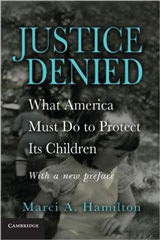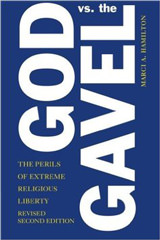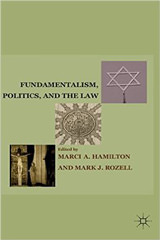Have you heard the rhetoric that a Biden administration signals a “decline” in religious liberty? It’s coming from conservative corners, including one Supreme Court Justice, who worried aloud to the Federalist Society about an impending devaluation in religious liberty. Don’t fall for it.
What they are mourning is a potential loss to their capacity to control non-believers with their beliefs. That’s not religious liberty; it’s religious triumphalism.
Since 1990, when the Supreme Court surveyed its free exercise cases and concluded that neutral, generally applicable laws are subjected to rationality review under the First Amendment, in Employment Div. v. Smith, religious lobbyists have falsely pedaled a theory that believers should have a right to overcome most laws that substantially burden their religious conduct. As Justice Antonin Scalia wrote for the majority in Smith, the First Amendment has never been a license to be a law unto oneself. Belief is absolutely protected, but conduct is not, as Cantwell v. Connecticut explicitly stated, and unless the government is discriminating against or targeting religious believers, the law governing conduct stands.
Conservative believers moved the boundary line from First Amendment-based legitimate religious liberty to religiously-motivated control of others significantly during the Trump Administration with one Executive Order after another; the seeds were planted with the misleadingly named Religious Freedom Restoration Act, or RFRA, in 1993. It is RFRA that has been cited one time after another by the outgoing Trump administration. This law, held unconstitutional, because a majority of the Court found it was so far removed from actual First Amendment doctrine in 1997 in Boerne v. Flores, is intended to give believers a sword against fellow Americans. From 1997 to 2000, the First Amendment once again held sway. The drive to use religious liberty as a mechanism for control was so strong, however, RFRA was re-enacted in 2000. The primary target was Title VII. This was how conservative believers could defeat civil rights.
Shame on the Democrats in 2000 who blinked and let RFRA be raised from the dead through the indefensible “unanimous consent” procedure. The RFRA hoax has been perpetuated by its misleading title and the intentional verbal slippage by religious advocates between First Amendment and statutory rights.
RFRA swords are particularly cruel, because the statute does not require the courts to consider the harm to third parties. It’s all about the believer.
For example, in Burwell v. Hobby Lobby, you had a for-profit chain of crafts stores that used the RFRA sword to cut through the female employees’ benefit plans. Now, Hobby Lobby was large and so forbidden from discriminating in hiring based on faith under Title VII. That means that there are many employees who do not necessarily share the Hobby Lobby owner’s faith. The owner of Hobby Lobby believed—against all science—that certain contraceptives were abortifacients, and for religious reasons he opposed abortion. So the Supreme Court, not surprisingly in an opinion written by the same Justice recently bemoaning a potential diminution of religious liberty, held that RFRA gave this for-profit business owner a right to unilaterally exclude these contraceptives from female employees’ benefit packages without consideration or weighing of the women’s civil rights under Title VII. This is a classic example of how RFRA is a weapon for believers to inflict their faith on non-believers.
The foundation has been built for for-profit employers to use RFRA to harm LGBTQ, too. In one fell swoop, the Court found that Title VII forbids discrimination against LGBTQ employees and then that religious employers have a backdoor through RFRA. In the Supreme Court’s recent decision in Bostock v. Clayton County, RFRA was explicitly named as the “super statute” tool to dismantle Title VII’s protections for LGBTQ employees, as I discussed here.
It’s not that members of Congress in 2000 didn’t understand that Title VII was being targeted by RFRA. It was explicitly raised in the 1999-2000 hearings. I know, because I personally raised it repeatedly. The religious entities misled lawmakers, though, saying that the test in RFRA would always be defeated by the “compelling interest” behind Title VII. They virtually guaranteed that no case involving Title VII would reach a different result if RFRA were invoked. Again, shame on Democrats.
Depending on the makeup of the Senate, Democrats now may have an opportunity to roll back the cruelty they unleashed with RFRA in 2000. The First Amendment, as currently interpreted and all by itself, is a potent weapon against discrimination and targeting, as laid out in Church of Lukumi Babalu Aye v. City of Hialeah. There is no need for RFRA, period. Repeal the whole thing, as well as the Religious Land Use and Institutionalized Persons Act (RLUIPA), if Democrats want to rein in the conservative will to power that now threatens public health, women, LGBTQ, and people of color. It’s also a weapon against child welfare. This “super statute” applies to child labor laws, child sex trafficking laws, and child abuse laws.
At the very least RFRA needs to be amended to halt its most destructive tendencies. There are several bills that have been drafted over the years to deter the use of RFRA as a lethal sword, including the Do No Harm Act and the Equality Act. Those Acts are behind the dire warnings of a “reduction” in religious liberty. In fact, there is not an iota of danger against legitimate religious liberty. The question is how much longer some religious actors can wield a mere statute to destroy the lives of fellow Americans.









